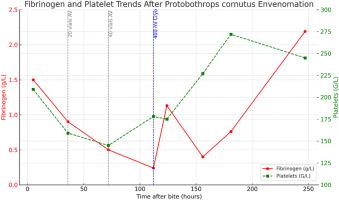Severe and prolonged hypofibrinogenemia following Protobothrops cornutus snake bite: A case report from Vietnam
IF 2.4
4区 医学
Q2 PHARMACOLOGY & PHARMACY
引用次数: 0
Abstract
We report a clinical case of severe and prolonged hypofibrinogenemia caused by envenomation from Protobothrops cornutus, an pit viper species found mainly in Vietnam and parts of southern China. A 60-year-old woman was bitten while hiking in Cuc Phuong national forest of Ninh Binh province, Vietnam. Although WHO guidelines discourage antivenom administration for minor coagulation abnormalities, in this case, the decision was made due to a fibrinogen level <1.0 g/l and the patient's risk factors, including age (60 years) and untreated arterial hypertension, increasing the risk of spontaneous cerebral hemorrhage. Her fibrinogen level progressively dropped from 1.5 g/l to a nadir of 0.24 g/l at 112 hours post-bite, despite administration of 60 vials of monovalent Trimeresurus albolabris antivenom (produced by the Institute of Vaccines and Medical Biologicals (IVAC), Nha Trang, Vietnam, and distributed by Vabiotech). A temporary increase to 1.13 g/l was observed after infusion of 400 ml of cryoprecipitate, but hypofibrinogenemia relapsed thereafter and only stabilized after 181 hours after Protobothrops cornutus bite. This clinical case highlights the distinctive coagulopathy caused by Protobothrops cornutus envenomation with severe and prolonged hypofibrinogenemia despite the use of large doses of monovalent Trimeresurus albolabris antivenom (which was not specific to P. cornutus) and cryoprecipitate while liver and kidney functions, creatine kinase (CK) levels, remained within normal limits, indicating that the venom primarily affected the coagulation system without causing damage to other major organs.

越南原猿人角蛇咬伤致严重和长期低纤维蛋白原血症1例。
我们报告了一个临床病例,严重和长期的低纤维蛋白原血症引起的毒害原角蝰,一种主要发现于越南和中国南方部分地区的毒蛇。一名60岁的妇女在越南宁平省Cuc Phuong国家森林徒步旅行时被咬伤。尽管世卫组织指南不鼓励对轻微凝血异常使用抗蛇毒血清,但在本病例中,这一决定是由于纤维蛋白原水平
本文章由计算机程序翻译,如有差异,请以英文原文为准。
求助全文
约1分钟内获得全文
求助全文
来源期刊

Toxicon
医学-毒理学
CiteScore
4.80
自引率
10.70%
发文量
358
审稿时长
68 days
期刊介绍:
Toxicon has an open access mirror Toxicon: X, sharing the same aims and scope, editorial team, submission system and rigorous peer review. An introductory offer Toxicon: X - full waiver of the Open Access fee.
Toxicon''s "aims and scope" are to publish:
-articles containing the results of original research on problems related to toxins derived from animals, plants and microorganisms
-papers on novel findings related to the chemical, pharmacological, toxicological, and immunological properties of natural toxins
-molecular biological studies of toxins and other genes from poisonous and venomous organisms that advance understanding of the role or function of toxins
-clinical observations on poisoning and envenoming where a new therapeutic principle has been proposed or a decidedly superior clinical result has been obtained.
-material on the use of toxins as tools in studying biological processes and material on subjects related to venom and antivenom problems.
-articles on the translational application of toxins, for example as drugs and insecticides
-epidemiological studies on envenoming or poisoning, so long as they highlight a previously unrecognised medical problem or provide insight into the prevention or medical treatment of envenoming or poisoning. Retrospective surveys of hospital records, especially those lacking species identification, will not be considered for publication. Properly designed prospective community-based surveys are strongly encouraged.
-articles describing well-known activities of venoms, such as antibacterial, anticancer, and analgesic activities of arachnid venoms, without any attempt to define the mechanism of action or purify the active component, will not be considered for publication in Toxicon.
-review articles on problems related to toxinology.
To encourage the exchange of ideas, sections of the journal may be devoted to Short Communications, Letters to the Editor and activities of the affiliated societies.
 求助内容:
求助内容: 应助结果提醒方式:
应助结果提醒方式:


